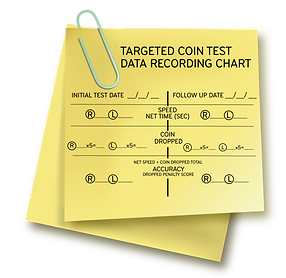HOW TO USE:
Test Procedure for Corbett Targeted Coin Test
Watch the Video
As the test is performed,
use this format to
collect/record data!

The Corbett Targeted Coin Test is equipped with a box and fitted lid with 16 multidirectional slots in four rows. At least 20 coins can be stored, for easy access, inside the box. Test participation requires 3 criteria:
-
The participant exhibits diminished light touch sensation according to Semmes Weinstein Monofilament Test.
-
The participant exhibits complete active fist closure to the palm.
-
The participant can perform finger tip to palm translation of coins. (ability to pick up 20 individual coins from table top while simultaneously storing coins in closed ulnar fist of hand without assistance from their other hand).
The Examiner should be thoroughly familiar with the test and should be capable of demonstrating the task. The Participant should be seated comfortably at the normal table height ( approximately 30”). The participant will rest closed fist with coins on tabletop directly in front of the upper extremity with the elbow flexed and forearm and wrist in neutral. The Corbett Targeted Coin Test box should be placed in line with the Participant’s hand to be tested, within 1 inch of closed fist. The other hand should be placed in the participant’s lap. This is the “Ready Position”.The Participant should take the test with the unaffected hand first. (In establishing normative data, the dominant hand should perform the test first.)
When the Participant is seated and in the “Ready Position” the Examiner introduces the test:
“This is a test to see how you can hold 20 coins in your palm and translate one coin from your palm to your thumb and fingertips and target a single coin accurately into the 16 sequential slots without dropping coins from your hand. If you drop or miss target a coin, go onto the next coin in your palm and place the coin in the next slot to establish your accuracy of target placement. You have extra coins in your palm for this. If coins slip out of your palm it will be noted in the scoring. Your speed for task completion will also be recorded. You will be given an opportunity to practice the complete board before a timed and scored test.”
Before each test the required task is demonstrated and practiced from the “Ready Position”. The participant is further instructed:
“When I say BEGIN, place coins into the top row starting at the notch corresponding with your hand holding the coins. Do not skip any slots and drop down to the next row in a zig zag pattern. Fill each row the same way you filled the preceding row until you have inserted 16 coins into all slots. You may have remaining coins in your hand which requires you to keep a fist during this test.”
For the RIGHT-HAND TEST, coins are placed in slots RIGHT TO LEFT and then drop down to the next row. Then reversing the direction left to right. Continue in this zig-zag pattern. The last slot is on the lower right corner.
For the LEFT-HAND TEST, coins are placed in slots LEFT TO RIGHT and then drop down to the next row. Then reversing the direction right to left. Continue in this zig-zag pattern. The last slot is on the lower-left corner.
“Do you have any questions? Are you ready? Begin a trial of the complete board.” ( to decrease the learning effect)
Using a stopwatch, start the clock when Examiner says “Begin”. Stop the clock when the coin drops through the last slot, and into box.
Record on the spreadsheet:
CTCT Purchase Order #, Pt #, DX, hand dominance, sex, age, occupation, and 3 values: (quantifies quality of performance) per hand.
Value #1) record, in seconds, the length of time (speed) required for placement of coins in 16 multi-directional slots.
Value #2) Record the number of “dropped” or “mis-targeted” coins times 5 second penalty.
Value #3) Summation of value #1 (speed) plus value #2 for quality of performance (accuracy).
ALTERNATIVE SCORE PER HAND: time only (quantifies speed)
Observation notes:
extraneous proximal UE compensatory AROM, for example: shoulder abduction
Supination for organizing coins into position
use of gravity with palm down or pronated forearm
dropping coins from ulnar fist
